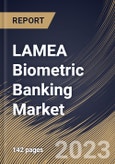Biometrics is an automated way of identifying customers using biological characteristics and features such as fingerprints, iris, and voice recognition. This characteristic is unique to each individual and challenging to acquire. This technology is becoming a sophisticated layer in numerous personal and business security systems.
The growth of biometric banking devices is primarily driven by enhanced security and decreased identity theft. As biometric authentication provides more secure identity verification procedures, the financial industry is rapidly adopting it. For user authentication, this technology uses physical characteristics like recognition of faces, fingerprint scanning, voice recognition, and retinal scans. Moreover, using biometrics in banking offers consumers a significant time-saving advantage over conventional banking procedures. In addition, the rise of mobile banking and contactless payments, as well as biometric authentication that meets the convenience needs of consumers, are the primary factors driving the market.
Integration of biometric technology with healthcare and banking systems in Latin America has been observed to be an emerging trend with great potential. The concept primarily revolves around using biometric data for healthcare verification, insurance claims, and payment processing. Biometric authentication can enhance the security of electronic health records. Patients can use biometrics to access their medical data securely, while banking integration can facilitate payments for medical services and insurance premiums.
The Brazil market dominated the LAMEA Biometric Banking Market, by Country in 2022, and would continue to be a dominant market till 2030; thereby, achieving a market value of $292 Million by 2030. The Argentina market is experiencing a CAGR of 19.4% during (2023 - 2030). Additionally, The UAE market would exhibit a CAGR of 18.4% during (2023 - 2030).
Based on Type, the market is segmented into Fingerprint, Facial Recognition, Hand Geometry, Iris Recognition and Others. Based on Vertical, the market is segmented into Retail, Transportation, Hospitality, Government, Healthcare and Others. Based on Component, the market is segmented into Hardware, Software and Services. Based on countries, the market is segmented into Brazil, Argentina, UAE, Saudi Arabia, South Africa, Nigeria, and Rest of LAMEA.
The market research report covers the analysis of key stake holders of the market. Key companies profiled in the report include Google LLC, NEC Corporation, Apple, Inc., The Charles Schwab Corporation, Mastercard Inc., Barclays Plc, Visa Inc., PayPal Holdings, Inc., Samsung Electronics Co. Ltd. and Aliph Brands.
Scope of the Study
Market Segments Covered in the Report:
By Type- Fingerprint
- Facial Recognition
- Hand Geometry
- Iris Recognition
- Others
- Retail
- Transportation
- Hospitality
- Government
- Healthcare
- Others
- Hardware
- Software
- Services
- Brazil
- Argentina
- UAE
- Saudi Arabia
- South Africa
- Nigeria
- Rest of LAMEA
Key Market Players
List of Companies Profiled in the Report:
- Google LLC
- NEC Corporation
- Apple, Inc.
- The Charles Schwab Corporation
- Mastercard Inc.
- Barclays Plc
- Visa Inc.
- PayPal Holdings, Inc.
- Samsung Electronics Co. Ltd.
- Aliph Brands
Unique Offerings
- Exhaustive coverage
- The highest number of Market tables and figures
- Subscription-based model available
- Guaranteed best price
- Assured post sales research support with 10% customization free
Table of Contents
Companies Mentioned
- Google LLC
- NEC Corporation
- Apple, Inc.
- The Charles Schwab Corporation
- Mastercard Inc.
- Barclays Plc
- Visa Inc.
- PayPal Holdings, Inc.
- Samsung Electronics Co. Ltd.
- Aliph Brands
Methodology

LOADING...








